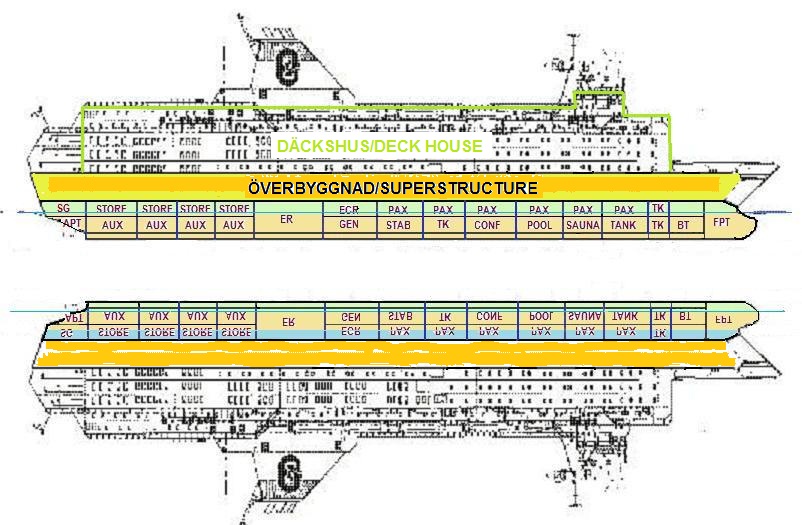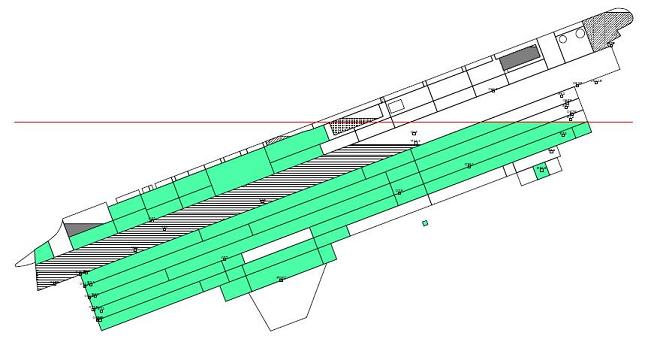|
|
|
|
The MV Estonia Sinking is still not explained 2021! Chalmers University supported scientific cheating and broke Swedish laws According two research establishments, SSPA/Safey at Sea, Ltd., at Gothenburg/Glasgow and HSVA at Hamburg 2008, the capsized but upside down still floating MV Estonia sank on 28 September, 1994! They were 2006-2008 paid >SEK 12 millions to explain why a ship, floating upside down, could sink. No details or calculations (!) are available in any reports about the capsized floating condition at 01.30 hrs and why/how it changed in the next 20 minutes permitting sinking! As seen in below (simple) figure the MV Estonia, prior capsize, floated normally on/displaced 11 930 m3 buoyancy in the hull (10 666 m3 air, 1 264 m3 solids, permeability 0.894 in 14 watertight compartments) according Archimedes with 6 886 m3 volume above waterline but below the watertight main deck (6156 m3 air and 730 m3 solids, permeability 0.894) reserve buoyancy. Total hull volume is 18.816 m3. Everybody including Archimedes agree to that. Above main deck in the superstructure and deck house were another 3 906 m3 of solids, i.e. buoyancy.  According above research establishments MV Estonia loaded 1 000's of tons of water in the superstructure >2 m above waterline, which resulted in the vessel capsizing and floating upside down at 01.30 hrs. Evidently the water in the superstructure doesn't affect buoyancy after capsize! Upside down, after capsize, MV Estonia thus still floats, now with 3 191 m3 of hull above waterline. About 5 012 m3 of water is then inside the 14 air tight hull compartment compressing the air there. The vessel displacement is still 11 930 m3: the displacement consists of two parts; 8.024 m3 compressed air/solids in the hull + 3.906 m3 solids in the superstructure/deck house. So the buoyancy of the capsized ship consists 67% of compressed air in the hull and 33% of submerged solids! It seems everybody also agrees to that. No air can escape from the 14 air tight hull compartments in this condition, so the vessel cannot sink. In model scale 1/40 and tests the model evidently floats higher after capsize, as the air pressure inside the model hull is less. But neither ship nor model can sink after capsize! Archimedes looks after that! Any undergraduate student using a calculator can conclude that a capsized, floating ship cannot sink. But according above research establishments and Chalmers University it can sink! They were paid to falsify it!
Dr. Dracos Vassalos of Safety at Sea, Ltd., has refused to assist in explaining the alleged loss of buoyancy of MV Estonia between 01.30 and 01.52 hrs. Vassalos is not interested to resolve the confusion he is causing. And he lectures ship stability and safety at sea at the University of Strathclyde. Poor undergraduates. Strangely enough the Safety at Sea Ltd 's partner SSPA, Gothenburg, part of Chalmers University, makes exactly the same unexplained error, when calculating buoyancy and floating after capsize and performing model tests of the sinking (SSPA report no. 4006 4100-4). None of the research establishments seems to know that capsized ships also float on buoyancy that was above waterline prior capsize! In order to sink the model, SSPA releases air from the capsized hull via two hidden valves in the bottom! This is unscientific cheating! SSPA is part of Chalmers University of Technology and has been informed about the manipulations. According the President of Chalmers, Ms Karin Markides, the Chalmers opinion is that the process has been open and well meets the demands put on a complex process such as this (letter Ref. No.:C2008/627 of 25 August 2008). She sounds like a prostitute being paid for services rendered. In a previous attempt to explain the Estonia sinking by the Swedish Board of Psychological Defence (SPF), the bow was 20 meters above waterline during the sinking. This does not happen in the latest studies. Now just the stern sinks first for unknown reasons (except that SSPA releases air there in the model tests). 
Previous attempt by SPF to explain sinking The Swedish Government states in its Proposition - prop. 2008/09:50 ”Ett lyft för forskning och innovation” (A step up for research and innovation) that the importance of public confidence remains and is reinforced, when handling questions of suspected manipulations of research at Swedish universities. The university is responsible to investigate suspicions about manipulations of research as per Chapter 1, § 16 of the Rules for Higher Education Institutions (högskoleförordningen) (1993:100). The university, as employer, must also take actions against employees, when manipulations of research have been observed. In the latest Proposition above the Government suggests that the responsibility of the university remains to investigate suspected manipulations of research, but that also an external investigation of suspected manipulations of research by experts outside the university may in certain cases contribute to the confidence of any investigation. In this case Chalmers University and Ms Karin Markides are breaking the law. Reason is to protect the people ordering a cover up of the incident 1994. The M/V Estonia sinking 1994 is therefore still not explained 2021.
|